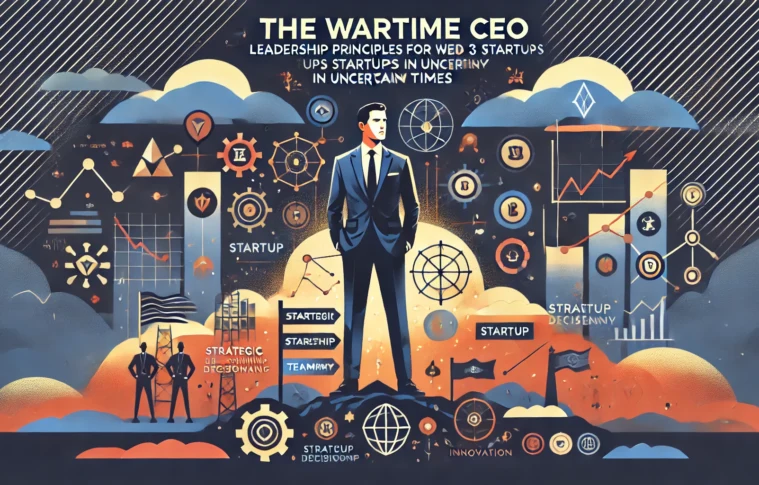In the rapidly evolving and unpredictable world of Web3, the concept of the “Wartime CEO” has become a vital leadership model. Unlike peacetime CEOs, who focus on long-term growth and stability, Wartime CEOs thrive in challenging environments where quick decisions, resilience, and adaptability are critical.
This article delves into the leadership principles of Wartime CEOs, sharing real-world examples of how Web3 leaders navigate market volatility, regulatory uncertainty, and technological disruptions to emerge stronger.
What is a Wartime CEO?
The Wartime CEO is a leader who excels during crises, uncertainty, and competitive pressure. In Web3, where the landscape changes rapidly, this leadership style is essential for tackling challenges such as:
- Regulatory Uncertainty: Adapting to unclear or evolving rules around cryptocurrencies and blockchain.
- Cybersecurity Threats: Addressing hacks, data breaches, and security vulnerabilities.
- Market Volatility: Navigating the ups and downs of cryptocurrency and NFT markets.
Unlike traditional leaders, Wartime CEOs are in the trenches, making tough calls and rallying their teams during high-stakes situations.
Key Traits of a Wartime CEO in Web3
1. Decisiveness Under Pressure
Wartime CEOs prioritize swift decision-making, even with incomplete information.
Example: When faced with a $625 million hack on their Ronin bridge, the Axie Infinity team quickly launched a recovery plan, reimbursing users and implementing new security measures. This decisive action preserved trust and ensured the platform’s survival.
2. Resilience in Crisis
Wartime CEOs view setbacks as opportunities to rebuild stronger. They inspire their teams to push forward despite adversity.
Example: DeFi platform Compound experienced a smart contract bug that distributed millions in unearned tokens. The team’s transparent response and collaborative bug fixes showcased resilience and restored community confidence.
3. Transparency with Stakeholders
In Web3, transparency builds trust, especially during crises. Wartime CEOs maintain open communication with users, investors, and regulators.
Example: After market turmoil in 2023, Coinbase CEO Brian Armstrong emphasized transparency by hosting public forums to address user concerns and clarify the company’s direction.
4. Adaptive Problem-Solving
In Web3, challenges evolve quickly. Wartime CEOs adapt strategies in real-time to stay ahead of competitors and threats.
Example: Polygon adjusted its roadmap to prioritize eco-friendly initiatives, ensuring compliance with global ESG regulations while maintaining its competitive edge.
Strategies for Web3 Leaders During Tough Times
1. Build a Crisis Management Plan
Anticipate potential crises and develop a roadmap for handling security breaches, regulatory crackdowns, or market crashes.
2. Engage Your Community
In Web3, community loyalty is critical. Keep users informed and involve them in decisions through mechanisms like DAOs.
3. Invest in Security
Allocate resources to cybersecurity, ensuring your platform is resilient against hacks and fraud.
4. Monitor Regulatory Changes
Work with legal experts to stay ahead of regulatory developments, adapting operations as necessary to maintain compliance.
5. Maintain Team Morale
Tough times can demoralize teams. Wartime CEOs inspire their teams with clear communication, recognition, and a shared vision for the future.
Case Studies of Wartime CEOs in Web3
1. Sam Bankman-Fried (Before the Fall of FTX)
As the founder of FTX, Sam Bankman-Fried initially demonstrated Wartime CEO traits by navigating the competitive crypto exchange market and scaling rapidly. However, his lack of transparency and regulatory issues ultimately led to FTX’s collapse, highlighting the importance of ethical leadership and clear governance.
2. Stani Kulechov (Aave)
The founder of Aave, Stani Kulechov, led his DeFi platform through the challenges of regulatory scrutiny and market volatility. By focusing on transparency and community involvement, Aave maintained its reputation as a secure and innovative DeFi solution.
FAQs on Wartime Leadership in Web3
What defines a Wartime CEO in Web3?
A Wartime CEO is a leader who thrives during crises, focusing on resilience, decisiveness, and transparency to navigate challenges.
How do Wartime CEOs handle regulatory challenges?
They collaborate with legal experts, monitor global regulations, and adapt their operations to comply with evolving laws.
Why is transparency important during tough times?
Transparency builds trust with stakeholders, ensuring continued support even during crises.
How can Web3 startups prepare for market volatility?
By diversifying revenue streams, building strong security systems, and engaging their communities to maintain loyalty.
Conclusion: Thriving in Uncertainty as a Wartime CEO
The Web3 landscape demands a new kind of leader—one who can navigate uncertainty with confidence, adaptability, and purpose. Wartime CEOs are not just crisis managers; they are visionaries who use challenges as a springboard for innovation and growth.
As Web3 continues to evolve, the leaders who embrace these principles will shape the future of decentralized technologies. Are you ready to lead your startup through the storm and emerge stronger?



